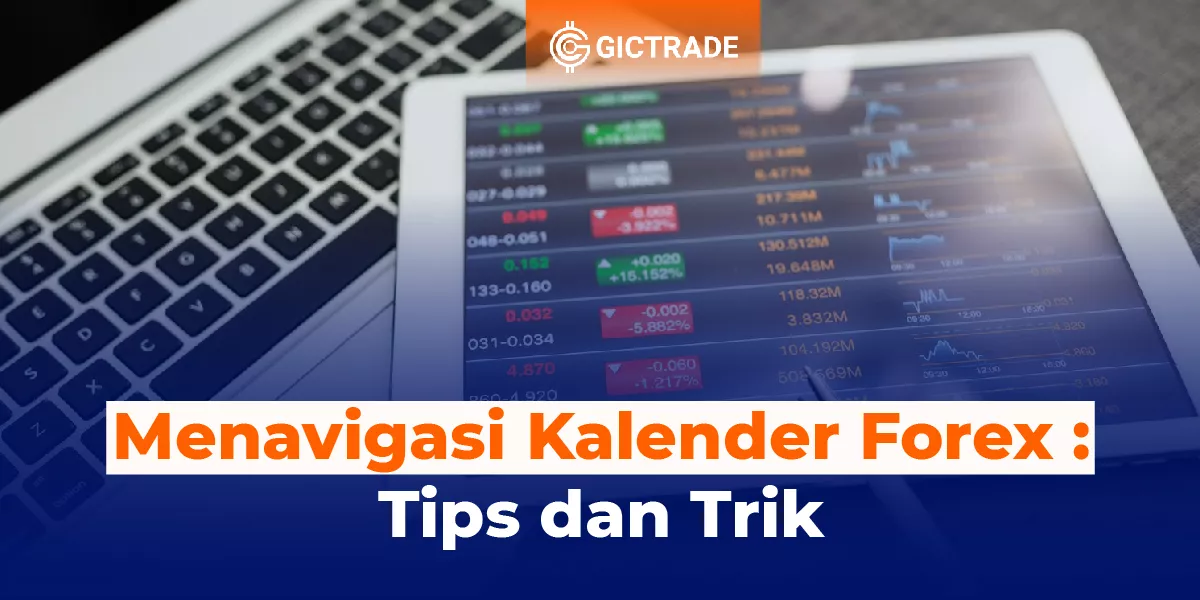Guide to Understanding Candlestick Charts- In the world of forex trading, a good understanding of candlestick charts is essential. Candlestick charts are one of the tools used to analyze price movements in the forex market. By understanding candlestick charts, you can read and analyze the price patterns that occur, so that you can make better trading decisions. In this guide, we will go into depth about candlestick charts and how you can use them in forex trading. From a basic introduction to complex candlestick patterns, this article will provide a complete guide in Indonesian on understanding candlestick charts for forex trading.
.webp)
Table of Contents
- What is Candlestick Chart?
- History of Candlestick Chart
- Components of a Candlestick Chart
- Types of Candlesticks
- Candlestick Patterns
- Candlestick Reversal Patterns
- Continuation Candlestick Patterns
- The Use of Candlestick Charts in Technical Analysis
- Identifying Profitable Candlestick Patterns
- Understanding Support and Resistance through Candlestick Charts
- Using Candlestick Charts to Set Stop Loss and Take Profit
- FAQ (Frequently Asked Questions)
- 1. What is candlestick chart?
- 2. How is a candlestick chart different from other charts?
- 3. How to identify candlestick patterns?
- 4. Do candlestick patterns always give accurate signals?
- 5. How can candlestick charts help in setting stop losses and take profits?
- 6. Are there any risks in forex trading using candlestick analysis?
- Conclusion
What is Candlestick Chart?
Candlestick charts are a type of chart used to analyze price movements in forex trading. This chart consists of a series of "candles" or "candles" that represent a price range over a specific period of time. Each candlestick has two important components, namely the body and shadow.
History of Candlestick Chart
Candlestick charts were first introduced in Japan in the 18th century by a rice trader named Munehisa Homma. Homma uses candlestick charts to analyze price movements in the rice market. Later, this method was introduced to the Western world by Steve Nison in 1989 through his book entitled "Japanese Candlestick Charting Techniques".
Components of a Candlestick Chart
Each candlestick consists of a body and a shadow. The body is the part that is filled between the opening and closing prices at a certain time period. If the closing price is higher than the opening price, then the body will be white or green. However, if the closing price is lower than the opening price, then the body will be black or red. Shadow is a line that connects the body to the highest price (upper shadow) and the lowest price (lower shadow) in that time period. The upper shadow indicates strong selling pressure (sellers), while the lower shadow indicates strong buying pressure (buyers).
Types of Candlesticks
There are several types of candlesticks that are commonly used in technical analysis. Some of them are:
- Bullish Candlestick: A candlestick with a white or green body indicates that the closing price is higher than the opening price.
- Bearish Candlestick: A candlestick with a black or red body indicates that the closing price is lower than the opening price.
- Doji: Candlesticks with very small or almost non-existent bodies indicate market uncertainty.
- Hammer: A bullish candlestick with a long upper shadow and a small body, indicates a potential upside price reversal.
- Shooting Star: Bearish candlesticks with long upper shadows and small bodies, indicate a potential price reversal down.
Candlestick Patterns
On candlestick charts, there are several basic patterns that can provide clues about the next price movement. Some common archetypes are:
- Bullish Engulfing: This pattern occurs when the lowest bearish candlestick that occurred before is completely covered by the bullish candlestick that occurs afterwards. This pattern indicates a potential upside price reversal.
- Bearish Engulfing: The opposite of a bullish engulfing pattern, this pattern occurs when the lowest bullish candlestick that occurred before is completely covered by a bearish candlestick that occurs afterwards. This pattern indicates a potential price reversal downside.
- Morning Star: This pattern consists of three candlesticks. The first candlestick is a bearish candlestick, then followed by a doji or candlestick with a small body indicating market uncertainty, and followed by a bullish candlestick that completely covers the body of the first candlestick. This pattern indicates a potential upside price reversal.
- Evening Star: The opposite of the morning star pattern, this pattern occurs when a bullish candlestick is replaced by a doji or candlestick with a small body followed by a bearish candlestick that completely covers the body of the second candlestick. This pattern indicates a potential price reversal downside.
Candlestick Reversal Patterns
In addition to the basic patterns, there are also more complex candlestick patterns that are used to identify potential price reversals. Some common reversal patterns are:
- Doji Star: This pattern occurs when there is an isolated doji after an uptrend or downtrend. This pattern indicates a potential price reversal.
- Hammer: This pattern has been mentioned before. Hammer occurs when the opening price, closing price, and low price are close to each other, while the upper shadow is long. This pattern indicates a potential upside price reversal.
- Hanging Man: The opposite of the hammer pattern, the hanging man occurs when the opening price, closing price, and high price are close to each other, while the lower shadow is long. This pattern indicates a potential price reversal downside.
- Dark Cloud Cover: This pattern occurs when a bullish candlestick is followed by a bearish candlestick that covers most of the bullish candlestick body. This pattern indicates a potential price reversal downside.
- Piercing Pattern: The opposite of the dark cloud cover pattern, the piercing pattern occurs when a bearish candlestick is followed by a bullish candlestick that covers most of the bearish candlestick body. This pattern indicates a potential upside price reversal.
Continuation Candlestick Patterns
In addition to reversal patterns, there are also candlestick patterns that indicate the continuation of the ongoing trend. Some common continuation patterns are:
- Bullish Harami: This pattern occurs when a small bullish candlestick is found within the range body of the previous bearish candlestick. This pattern suggests that the bullish trend is likely to continue.
- Bearish Harami: The opposite of the harami bullish pattern, this pattern occurs when a small bearish candlestick is found within the previous bullish candlestick body range. This pattern suggests that the bearish trend is likely to continue.
- Rising Three Methods: This pattern consists of a bullish candlestick followed by three or more bearish candlesticks with smaller bodies and within the range of the previous bullish candlestick body. This pattern suggests that the bullish trend is likely to continue.
- Falling Three Methods: The opposite of the rising three methods pattern, this pattern consists of a bearish candlestick followed by three or more bullish candlesticks with smaller bodies and within the range of the previous bearish candlestick body. This pattern suggests that the bearish trend is likely to continue.
The Use of Candlestick Charts in Technical Analysis
Candlestick chart It is widely used in technical analysis to assist traders in identifying trading opportunities. By understanding candlestick patterns and observing the formations that form, traders can make better trading decisions. Some of the uses of candlestick charts in technical analysis are:
- Identifying trend reversals: By paying attention to reversal candlestick patterns, traders can identify potential trend reversals and take trading positions accordingly.
- Confirming the signals of other indicators: Candlestick charts can be used to confirm signals generated by other technical indicators, such as moving averages or oscillators. For example, if the indicator shows a buy signal and there is a bullish candlestick pattern, then it can strengthen the decision to enter a long position.
- Determining support and resistance levels: Through candlestick charts, traders can observe price patterns that indicate support and resistance levels. This can help traders determine the optimal stop loss and take profit levels.
- Observing market sentiment: Candlestick charts can provide an idea of market sentiment, whether bullish or bearish. By understanding the market sentiment, traders can make trading decisions accordingly.
Identifying Profitable Candlestick Patterns
To identify profitable candlestick patterns, it is important for traders to understand and observe the patterns that form on the candlestick chart. Some patterns that can be considered profitable include:
- Bullish Engulfing: This pattern indicates a potential bullish price reversal. Traders may consider entering a long position after a bullish engulfing pattern.
- Hammer: This pattern indicates a potential upside price reversal. Traders may consider entering a long position after a hammer pattern has occurred.
- Piercing Pattern: This pattern indicates a potential bullish price reversal. Traders may consider entering a long position after a piercing pattern occurs.
- Harami Bulls: This pattern indicates that the bullish trend is likely to continue. Traders may consider maintaining a long position or entering a new long position after a bullish harami pattern occurs.
However, it is important to remember that candlestick patterns do not always provide accurate signals. It is important to use candlestick patterns as one of the confirmation tools, not as the sole basis for trading decision-making.
Understanding Support and Resistance through Candlestick Charts
Candlestick charts can be used to observe and understand support and resistance levels in forex trading. A support level is a price level where demand is strong enough to prevent the price from falling further, while a resistance level is a price level where supply is strong enough to prevent the price from rising further. In candlestick charts, support and resistance levels can be identified through the price patterns that are formed. For example, if there are bullish patterns that fail to break through the resistance level, it can indicate the strength of the resistance. Conversely, if there are bearish patterns that fail to break through the support level, it can indicate the strength of the support.
By understanding support and resistance levels, traders can use this information to determine the optimal stop loss and take profit levels in their trading strategies.
Using Candlestick Charts to Set Stop Loss and Take Profit
Candlestick charts can be a useful tool in determining stop loss and take profit levels in forex trading. Stop loss is the price level at which traders set a limit on their acceptable losses, while take profit is a price level at which traders set their profit targets. In using candlestick charts to set stop losses and take profits, traders can pay attention to the price patterns that form around support and resistance levels.
For example, if there is a bearish pattern forming near a resistance level, this could be a signal to place a stop loss above that resistance level. Conversely, if there is a bullish pattern forming near the support level, this can be a signal to place a stop loss below the support level. At the same time, traders can also notice patterns that indicate a potential price reversal or trend continuation. For example, if there is a reversal pattern indicating a bullish price reversal, traders may consider placing a take profit near a potential resistance level.
Conversely, if there is a continuation pattern that indicates a continuation of the uptrend, traders may consider placing the take profit at a higher level.
Join GIC, the Best Forex Trading Platform for Beginner Traders
Not familiar with GIC? Let's get acquainted. Unlike other conventional brokerage firms, GIC through the GICTrade platform provides a solution for traders who do not want to be charged with high trading fees.
GICTrade is a peer-to-peer trading platform that brings together traders and market makers. Traders will benefit from the absence of commission fees and low swap fees and spreads due to the presence of market makers as liquidity providers.
You can also join the trader community on GICtrade's Telegram to ask fellow traders directly about their trading experience. In addition, on YouTube GIC, traders can also learn to trade for free! What are you waiting for?
FAQ (Frequently Asked Questions)
1. What is candlestick chart?
A candlestick chart is a type of chart used in technical analysis to visualize the price movement of an asset, such as a currency pair in forex trading. This chart consists of candlesticks that show the opening price, closing price, as well as the highest and lowest prices in a given time period.
2. How is a candlestick chart different from other charts?
Candlestick charts have the advantage of providing clearer and more visual information about price movements compared to other charts, such as line charts or bar charts. Candlestick charts are also able to indicate market sentiment through the price patterns that are formed.
3. How to identify candlestick patterns?
To identify candlestick patterns, traders need to observe the shape and position of the candlestick and its relationship to the previous candlestick. Certain patterns, such as dojis, hammers, or engulfing, can indicate a potential price reversal or trend continuation.
4. Do candlestick patterns always give accurate signals?
No, candlestick patterns do not always provide accurate signals. It is important to use candlestick patterns as a confirmation tool, not as the sole basis for trading decision-making. Always combine candlestick analysis with other technical analysis.
5. How can candlestick charts help in setting stop losses and take profits?
By observing the price patterns that form around the support and resistance levels, traders can determine the optimal stop loss and take profit levels. Patterns that indicate a price reversal or a continuation of the trend can be a signal to determine these levels.
6. Are there any risks in forex trading using candlestick analysis?
As in any form of trading, forex trading also involves risk. Candlestick analysis is only one of the tools in technical analysis and does not guarantee a definite result. It is important to always practice good risk management and combine technical analysis with wise financial management.
|
Also Read : 5 Best Forex Indicators For Technical Analysis |
Conclusion
This guide has discussed the use of candlestick charts in forex trading. By understanding candlestick patterns and observing the formations that form, traders can make better trading decisions. Candlestick charts can be used to identify trend reversals, confirm signals from other indicators, determine support and resistance levels, observe market sentiment, and set stop losses and take profits. However, it is important to remember that candlestick analysis is not a guarantee of success. Traders should continue to conduct in-depth analysis and research before making trading decisions.
Always use good risk management and consider other factors such as fundamental analysis and overall market conditions. With practice and experience, the use of candlestick charts can be a useful tool in improving your forex trading skills.
 Last:
Last: 






